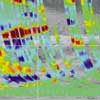
| PROGRAM & MISSIONS |
|
Geology
Goal 3: Characterize the Geology of Mars
For example, Mars is home to incredibly large volcanoes, which can be 10 to 100 times larger than those on Earth. One reason for this difference is that the crust on Mars doesn't move the way it does on Earth. That means the total volume of lava piles up into one, very large volcano. The Magnetism of Mars Gives Clues to the Planet's Interior and More
Rocks on Mars Can Tell Us About the Planet's History and Its Potential for Harboring Life Of fundamental importance are the age and composition of different types of rocks on the Martian surface. Geologists use the age of rocks to determine the sequence of events in a planet's history. Composition information tells them what happened over time. Particularly What other materials might be trapped in those rocks with information about the planet's history? How are the different rock types distributed across the surface? Future orbiting and landed missions will carry special tools designed to help answer these questions. Twelve Mars meteorites discovered on Earth can also give us clues about the planet. Learn more about Meteorites from Mars from the Johnson Space Center. |



